Consumption of polyester filament and textiles diversified in H1 2023
Demand for PFY was diversified in the first half of 2023, and the growth rate of export was higher than that of domestic sales. Export volume basically covered the increase of PFY production. The increase in domestic sales and the reduction of inventory was basically consistent.
As for the consumption of downstream products, domestic sales were better than export. Actually, the rise of domestic sales was mainly contributed by the inventory increase of middle products and downstream finished goods.
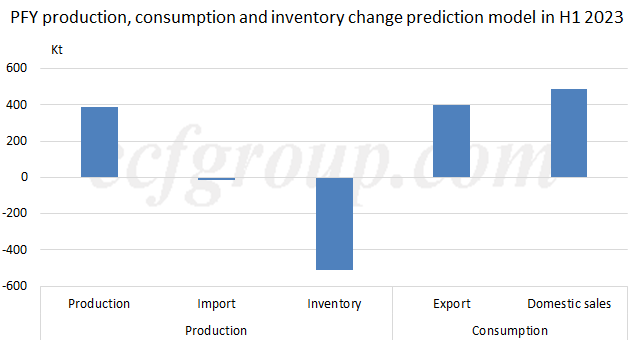
1. PFY export exceeded expectation and the increase of export basically covered the growth of production
Exports of PFY were at 1720.7kt in Jan-May, 2023, up by 31.01% year on year. Factories reflected that exports of PFY are not small too in Jun. Total PFY exports are estimated to be around 2.07 million tons in the first half of 2023 when PFY export in Jun is estimated at 350kt, which will hit record high, up by 440kt or 27% on annual basis.
Soaring PFY exports in H1 2023 were mainly attributed to the following reasons: firstly, China-made PFY enjoyed cost advantage with integration of upstream and downstream production. Secondly, the sea freight to nearby routes sharply declined. Thirdly, some buyers purchased in advance due to policy issue, such as the BIS certification of India.
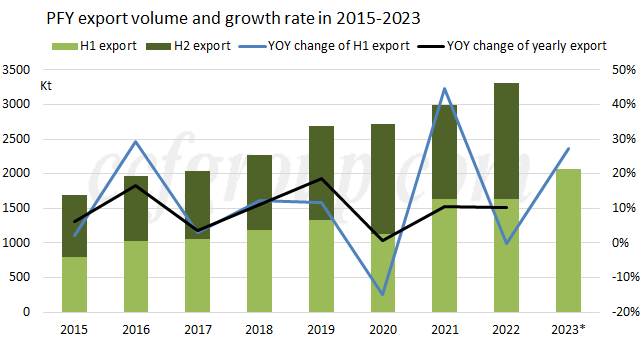
The PFY production increased by near 400kt in the first half of 2023. That meant export basically covered the growth of production. Domestic sales of PFY was basically flat with the corresponding period of last year.
2. Domestic retail sales of textiles and apparels recovered but consumers still held cautious mindset
The retail sales of social consumer goods was at 18.76 trillion Yuan in Jan-May, 2023, a year-on-year rise of 12.7%. The retail sales of textiles and apparels was at 561.91 billion Yuan in Jan-May, 2023, up by 17.6% year on year. In terms of consumption value, it apparently increased on the year, but the proportion of retail sales of textiles and apparels in total retail sales of consumer goods remained at 3%, which was low since the outbreak of pandemic.
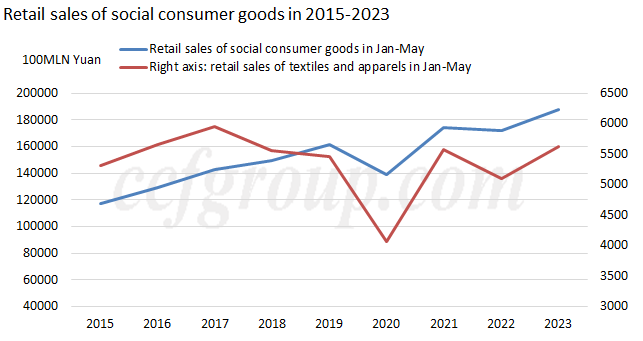
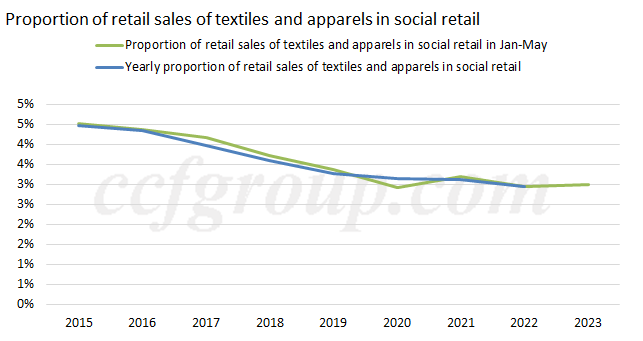
3. Export of textiles and apparels was still under pressure and the pressure of apparels was bigger than that of textiles
Exports of textiles and apparels were weak, which was mainly because major textile and apparel importers such as Europe and US imported less.
| Import and retail sales of major economies outside China | |||||
| Nation | Import of textiles and apparels | Retail sales of textiles and apparels | |||
| Time | Total import | Import from China | Import from other nations | ||
| US | Jan-Apr | The import of textile and apparel amounted to $37.36 billion, a year-on-year decrease of 23.1%. | Imports from China totaled US$8.34 billion, down 33.7% from the same period last year, accounting for 22.3%, down 3.6 percentage points on the year. | Imports from Vietnam, India, Bangladesh and Mexico fell by 26.9%, 21.1%, 18.8% and 2.3% respectively year on year, accounting for 12.8%, 9%, 7.5% and 5.3%, respectively, increasing by -0.7, 0.2, 0.4 and 1.1 percentage points, respectively. | Retail sales of clothing stores in May were $25.63 billion, unchanged from the previous month, down 0.2% from the same period of last year, and an increase of 15.6% over the same period in 2019. |
| EU | Jan-Apr | The import of apparel reached $31.44 billion, a year-on-year decrease of 9.8%. | Imports from China were at US$7.78 billion, down 19.8% year on year, accounting for 24.8%, down 3.1 percentage points over the corresponding period of last year. | Imports from Bangladesh, Turkey, India and Vietnam increased by -6.1%,-13.8%,-1% and 1.6% year on year respectively, with proportion up by 0.9,-0.5, 0.6 and 0.5 percentage points, respectively. | Retail sales of clothing fell slightly by 0.7% in April from a year earlier in German; retail sales of clothing in the Netherlands were down 0.9% from a year earlier; and household consumption of textile, clothing and leather products in France reached 4.1 billion euros ($4.48 billion), down 1.1% year on year. |
| UK | Jan-Apr | The import of apparel approached $7.09 billion, down by 13.5% year on year. | Imports from China reached US $1.56 billion, down 24.5% on annual basis, taking up 22%, down 3.2 percentage points on the year. | Imports from Bangladesh, Turkey, India and Italy rose by 1.7%,-22.5%, 2.7% and-14.4% respectively on annual basis, with the market share up by 3.1,-1, 1.2 and-0.1 percentage points respectively. | From Jan to May, retail sales of textiles, clothing and footwear in the totaled 22.74 billion pounds in UK, an increase of 11.8% over the same period last year and 12.9% higher than that of the same period before the epidemic. |
| Japan | Jan-Apr | The import of apparel approached $8.57 billion, up by 3.7% on annual basis | Imports from China totaled US$4.4 billion, down 2.1% on the year, accounting for 51.4%, down 3 percentage points year on year. | Imports from Vietnam, Bangladesh, Myanmar and Cambodia advanced by 14.2%,-2%, 37.8% and 1.7% respectively year on year, with the proportion increasing by 1.4,-0.3, 1.3 and -0.1 percentage points respectively. | From Jan to Ap, retail sales of textiles and clothing totaled 2.8 trillion yen, an increase of 2.5% over the same period last year, down 22.1% from the same period before the epidemic. |
| Australia | Jan-Apr | The import of apparel totaled $3.02 billion, down by 4.2% on annual basis | Imports from China amounted to US$1.8 billion, down 7.4% from the same period of last year, occupying 59.6%, down 2.1 percentage points on annual basis. | Imports from Bangladesh, Vietnam, India and Indonesia increased by 7.3%, 6.8%,-1.1% and -0.7% on annual basis respectively, with the market share up by 1.2, 0.7, 0.1 and 0.1 percentage points respectively. | Retail sales in clothing and footwear stores reached US $11.91 billion from Jan to Apr, an increase of 7.9% on annual basis and 39.7% over the same period in 2019. |
| Canada | Jan-Apr | The import of apparel as at $3.81 billion, down by 1.7%year on year. | Imports from China totaled US$1.07 billion, down 10.6% from the same period of last year, accounting for 27.9%, down 2.8% percentage points year on year. | Imports from Bangladesh, Vietnam, Cambodia and India moved up by-1.3%,-0.7%, 0.2% and 8.1% respectively year on year, with the market share up by 0.1, 0.1, 0.2 and 0.4 percentage points respectively. | Retail sales of clothing stores from Jan to Apr were C $11.42 billion, an increase of 13.5% over the same period last year and 19% over the same period in 2019. |
Under RMB basis, textile and clothing exports totaled 812.37 billion yuan from Jan to May, an increase of 2.1% over the same period last year (the same below), of which textile exports totaled 390.48 billion yuan, down 2.4%, and clothing exports amounted to 421.89 billion yuan, up 6.6%. Under US dollars basis, from Jan to May, textile and clothing exports reached US$118.2 billion, down 5.3%, of which textile exports were US$56.83 billion, down 9.4%, and clothing exports totaled US$61.37 billion, down 1.1%.
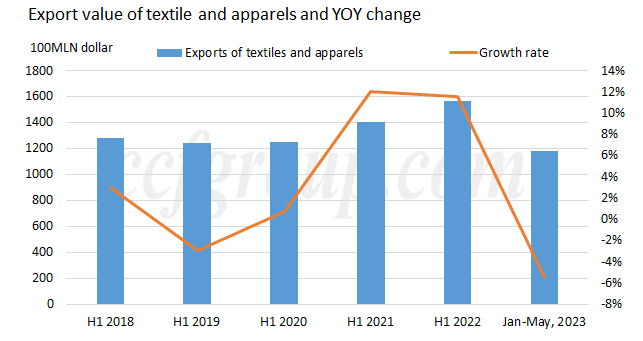
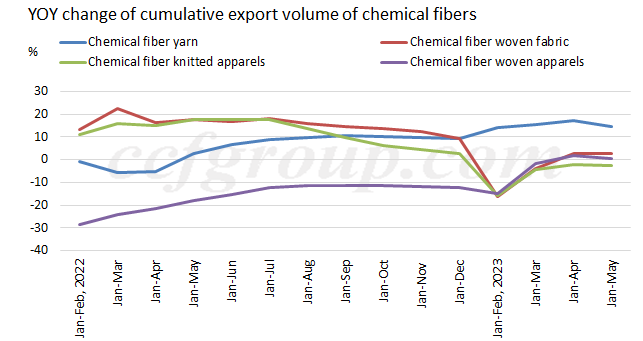
As for export volume, from Jan to May, knitted clothing exports reduced by 5.79% compared with the same period of last year, woven clothing exports decreased by 0.77% on annual basis, woolen leather clothing exports fell by 3.17% year on year, other clothing exports decreased by 8.09% on the year, yarn exports increased by 13.16% over the same period of last year, fabric exports descended by 1.96% year on year, and finished goods exports rose by 1.67% on the year. Chemical fiber woven clothing export improved but knitted clothing weakened; fiber export was better, but chemical fiber woven fabric (grey fabric) export was weak.
The operating rate of water-jet mills, warp knitting mills and circular knitting plants in Zhejiang and Jiangsu also indicated apparently better woven market than knitted sector.
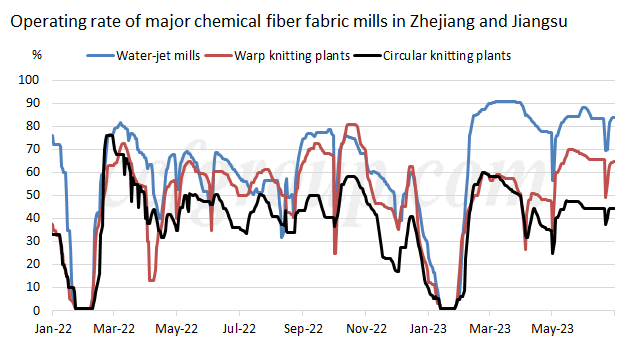
From the angle of export price, the export price of fibers decreased apparently year on year while that of apparels was higher than the corresponding period of last year.
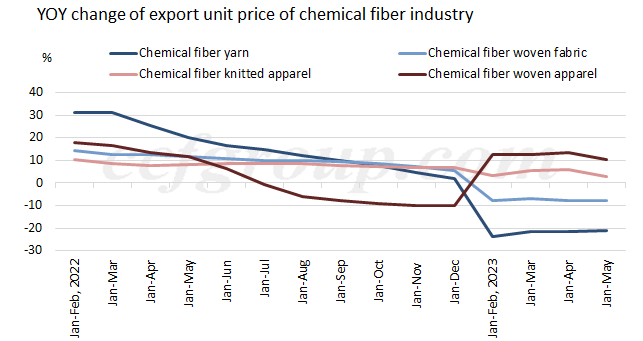
4. The increase of fabric stocks contributed to the increase in domestic sales of PFY
The capacity increase of DTY market and fabric sector was bigger than that of PFY market in 2020-2022. The reservoir function of DTY market and fabric sector expanded.
As for the inventory of PFY and downstream fabric market in the first half of 2023, compared with the end of 2022, inventory of POY and FDY fell by around 1 day and that of DTY rose by around 10 days in big companies.
PFY stocks of downstream fabric mills fell by around 6 days while the stocks of grey fabrics rose by near 8 days. The increase of grey fabrics contributed to some increase in domestic sales of PFY. In addition, except for the increase of grey fabric inventory in factories, the replenishment of grey fabrics from traders and retailer also grew. Therefore, the growth of domestic sales of PFY was mainly attributed to the replenishment of downstream sectors.
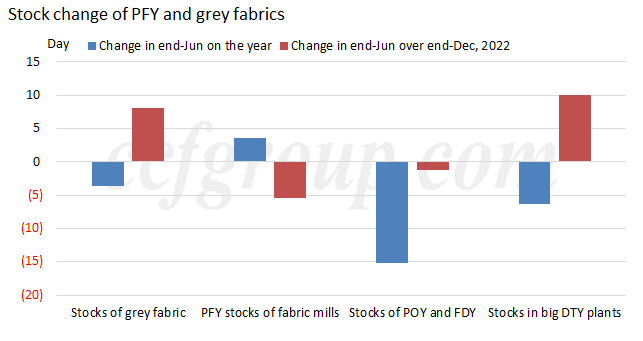
- Top keywords
- Cotton Price
- Cotton Futures Price
- Cotton Futures
- CZCE
- PTA Futures Price
- Chemical Fiber
- Polyester Prices
- Wool price
- PTA Futures
- Shengze Silk
- China
- Yarn Price
- price
- China Textile City
- Fibre Price
- Benzene Price
- Cotton
- Index
- Cotton Index
- PTA
- fabric price
- NYMEX
- Top 10
- textile industry
- Spot Cotton
- Cotton Yarn
- Polyester Price
- Futures
- PTA Price
- cotton yarn price

